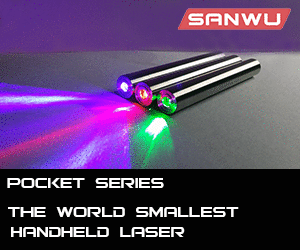From Slashdot: http://www.eetimes.com/showArticle.jhtml?articleID=209800332

Welcome to Laser Pointer Forums - discuss green laser pointers, blue laser pointers, and all types of lasers
How to Register on LPF | LPF Donations
Navigation
Install the app
How to install the app on iOS
Follow along with the video below to see how to install our site as a web app on your home screen.
Note: This feature may not be available in some browsers.
More options

You are using an out of date browser. It may not display this or other websites correctly.
You should upgrade or use an alternative browser.
You should upgrade or use an alternative browser.
Collimating lasers without lenses
- Thread starter Petrovski
- Start date


brtaman
0
- Joined
- Jun 12, 2008
- Messages
- 1,199
- Points
- 48
Very nice. This will have a huge impact on future lasers for enthusiast, that is if handheld lasers above 5mw are still legal by then, judging by the crap I read everyday that seems less and less likely...
"The plasmonic collimator is applicable to all semiconductor lasers,"
hehe plasmonic (seems like a word a movie script writer would make up for a cheesy science based move hehe ), Very interesting principle of operation though, good find [smiley=thumbsup.gif]
), Very interesting principle of operation though, good find [smiley=thumbsup.gif]
brtaman
"The plasmonic collimator is applicable to all semiconductor lasers,"
hehe plasmonic (seems like a word a movie script writer would make up for a cheesy science based move hehe
brtaman
Yeah interesting isn't it? I had to look up the word plasmon. According to wiki a plasmon is:
I do not pretend to understand this to the letter, but the way I understand it a plasmon is an oscillating plasma particle, resulting in visible light. Anybody feel free to correct/verify this. ;D
Not difficult to find for me btw, I check slashdot almost daily.
In physics, a plasmon is a quantum of a plasma oscillation. The plasmon is the quasiparticle resulting from the quantization of plasma oscillations just as photons and phonons are quantizations of light and sound waves, respectively. Thus, plasmons are collective oscillations of the free electron gas density, often at optical frequencies. They can also couple with a photon to create a third quasiparticle called a plasma polariton.
I do not pretend to understand this to the letter, but the way I understand it a plasmon is an oscillating plasma particle, resulting in visible light. Anybody feel free to correct/verify this. ;D
Not difficult to find for me btw, I check slashdot almost daily.
- Joined
- Jan 7, 2007
- Messages
- 6,322
- Points
- 83
Interesting -- Cutting grooves like that remind me of a Fresnal lens.
Mike
Mike
- Joined
- Aug 25, 2007
- Messages
- 2,007
- Points
- 63
It's a propagating oscillation of the electron density in a material. It's not an oscillating particle persay, but the instead the "plasmon" is a wave that moves through a region, a collective oscillation of electron density. Like a photon is an oscillation in an electric field that moves through an area, a plasmon is a wave in the electron density that moves through an area. It is quantized, which means that a certain size of oscillation is the absolute minimum, and anything bigger will be a sum of many the smallest possible quantum. This wave can be modeled as a particle (hence the name quasiparticle) for convenience and because that's kind of how it works, and it just makes it much easier to deal with.
What they have here are surface plasmons, which will greatly influence the light coming from the laser. They have demonstrated that they can achieve some control of the light coming out of the laser by purpose-designing surface plasmons. And with further work, they should be able to further control the surface plasmons to get the the behavior they want out of the light. But this is not trivial, etching patterns onto the facets of a laser is anything but easy. Glad I'm not the one having to try it. It is one of those things they *might* be able to do a one-off type thing a little easier with something like a FIB (focused ion beam), but that carries its own problems. Doing lithography on the small sides of a laser diode, yeah, that's tough.
What they have here are surface plasmons, which will greatly influence the light coming from the laser. They have demonstrated that they can achieve some control of the light coming out of the laser by purpose-designing surface plasmons. And with further work, they should be able to further control the surface plasmons to get the the behavior they want out of the light. But this is not trivial, etching patterns onto the facets of a laser is anything but easy. Glad I'm not the one having to try it. It is one of those things they *might* be able to do a one-off type thing a little easier with something like a FIB (focused ion beam), but that carries its own problems. Doing lithography on the small sides of a laser diode, yeah, that's tough.
jamilm9
0
- Joined
- Jan 12, 2008
- Messages
- 1,864
- Points
- 38
i always thought it would be neat if the window in a closed can lasers was a lens.

